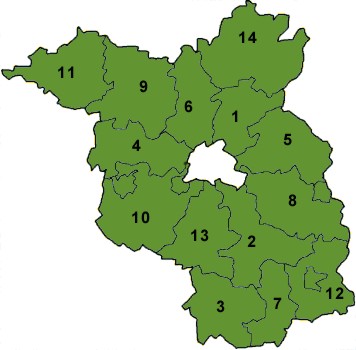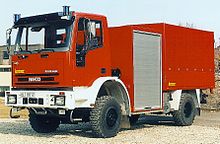Fire protection units in Brandenburg

The fire protection units of the state of Brandenburg ( abbreviation : BSE) are units designed as part of the Brandenburg disaster control system that were created because of the high risk of forest fires there. In general, however, they are also intended for other fire and major damage situations . Similar units with the same or approximately the same tasks are called district fire brigade readiness in other federal states .
There are a total of 15 units. The fire protection units originally had a nominal strength of 1: 134 (1 unit leader and 134 emergency services) and 22 vehicles . After the introduction of the Disaster Control Ordinance in 2012, the minimum number of personnel was reduced to 73 emergency services and 15 vehicles.
The emergency services essentially consist of volunteers from the volunteer fire brigades in Brandenburg. The vehicles are usually housed in fire stations or fire stations of these fire departments and are also used for regular emergency services.
In the event of an emergency, these are collected at so-called assembly points, depending on the requirements, and then go together to the location ( convoy ). Depending on the location, the units are ready to leave within approx. 4 hours. Therefore, these units are suitable to relieve or provide further support to the first emergency services in a major disaster situation .
distribution
There are a total of 15 units in the 14 districts. The Oder-Spree district has 2 BSEs.
|
history
The structure of the fire protection unit is based on circular III No. 76/93 of the Brandenburg Ministry of the Interior from 1993 . In 2012, the ordinance on the units and facilities of disaster control (Disaster Control Ordinance, KatSV) was issued in order to take into account the changed conditions of the tasks and technology.
The fire protection units of that time were used, among other things, for:
- the Oder floods (1997 and 2010)
- the floods in Central Europe in spring 2010
- the Elbe flood (2002)
- a major fire in a tire warehouse near Berlin-Schmöckwitz (2005)
- a fire at a landfill in Bernau near Berlin (2005)
- the football World Cup 2006 in Berlin (standby / reserve)
- various forest and field fires
- the 2013 flood
- a fire in a warehouse in Fürstenwalde / Spree (2016)
- twice in the forest fire near Treuenbrietzen (2018)
Structure (before 2012)
The following structure for the structure of a fire protection unit was established in 1993:
| part | Strength | equipment |
|---|---|---|
| Unit management | 1: 3 | 1 lead vehicle |
| Train 1 | 1:17 | 5 fire trucks , 1 Meldekrad |
| Move 2 | 1:36 | 1 fire fighting group vehicle 16 as a lead vehicle , 3 LF 8-STA , 1 Meldekrad |
| Train 3 | 1:36 | 1 fire fighting group vehicle 16 as a lead vehicle , 3 LF 8-STA , 1 Meldekrad |
| Move 4 | 1:36 | 1 fire fighting group vehicle 8 as a train-lead vehicle , 2 LF 8-STA or 2 hose trolleys , 1 Meldekrad |
| care | 1: 1 | 1 utility vehicle |
| Overall strength | 1: 134 |
Special compositions:
The "Assistance Train" was a special unit for tasks of technical assistance . This was only available in the Oder-Spree district. The equipment consisted of 3 rescue vehicles 2 and an equipment vehicle I of the technical relief organization (THW) .
The "dangerous goods train" was suitable for use with dangerous substances and goods . It consisted of: 1 dangerous goods equipment car , 1 NBC reconnaissance vehicle , 1 fire fighting group vehicle 16 , 1 decon truck P , 1 breathing protection equipment car
The care and support component was a ambulance and a large-capacity ambulances equipped.
Current structure
In the course of the introduction of the Disaster Control Ordinance in 2012, the minimum number of staff was reduced. According to KatSV, the following structure was defined:
| part | Strength | equipment |
|---|---|---|
| Unit management | 2/0/2/4 | 1 command vehicle 1 as command vehicle of the fire protection unit, 1 reporting vehicle (quad or motorbike) |
| 1st train - fire fighting TLF | 1/6/15/22 | 1 command car as a command vehicle , 5 tank fire engines |
| 2nd train - fire fighting LF | 1/3/18/22 | 1 command vehicle as a command vehicle , 2 fire fighting group vehicle 20 |
| 3. Train - fire water supply | 1/4/20/25 | 1 command car as a command vehicle , 1 hose trolley for disaster control , 2 fire fighting vehicle for disaster control |
| Overall strength | 5/13/55/73 |
equipment
The BSE is equipped with vehicles by the above. Regulated circular. At the time of publication, the LF 8-TS8-STA fire fighting group vehicle was decisive. Very few vehicles of this type are left in the units in the country. Modern all-terrain hose trolleys are now in use.

The LF 16-TS fire fighting vehicles will be integrated from the vehicles stationed by the federal government in Brandenburg.

The TLF 16/45 (forest fire TLF of the “Brandenburg” type) procured by the state are also used.
Some emergency vehicles still consist of former GDR fire brigades and former NVA vehicles that have been converted or equipped for today's purpose. The districts are gradually replacing these with more modern vehicle technologies.
Web links
- Circular III No. 76/93 - List of fire protection units (PDF; 25 kB) - outdated
- Disaster Control Ordinance as of 2012 on the homepage of the Brandenburg Fire Brigade Association. V.
- Disaster control in the state of Brandenburg - Disaster control ordinance and administrative regulations on the homepage of the Ministry of the Interior and Local Affairs of the state of Brandenburg (PDF; 84 kB)
- Report on the fire protection unit (PDF; 56 kB)

